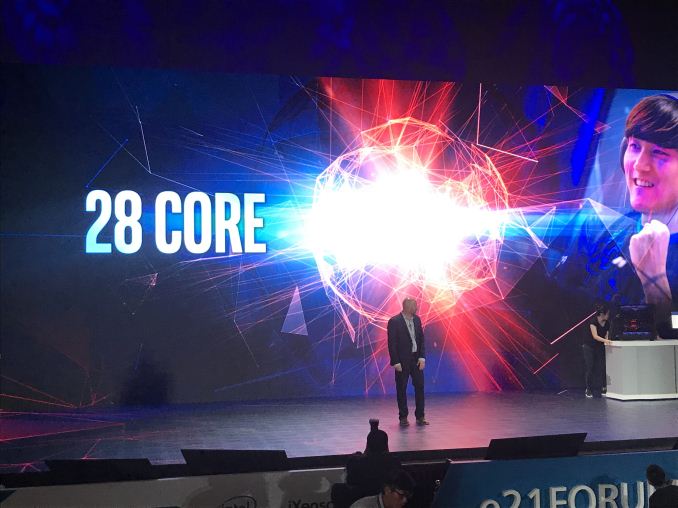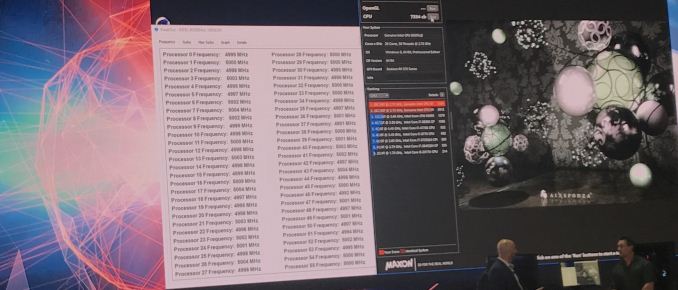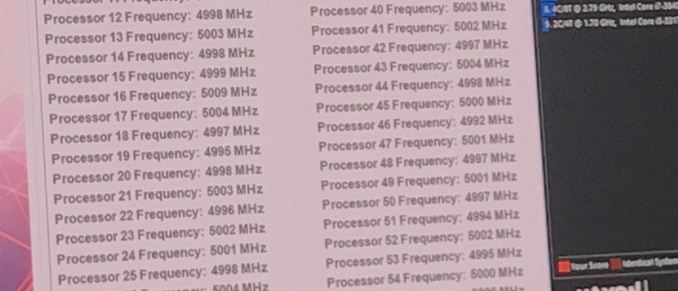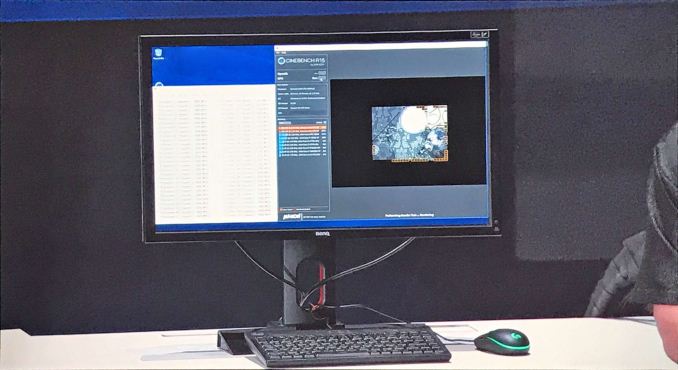Intel’s 28-Core 5 GHz CPU: Coming in Q4
by Ian Cutress on June 5, 2018 3:09 AM EST- Posted in
- CPUs
- Intel
- Trade Shows
- Computex 2018
- 28-core

Update 06/08: Intel has since backtracked on its initial statements, clarifying that while a 28-core part is coming in Q4 of this year, its stock frequency will not be 5GHz. Rather this was a (very poorly communicated) overclocking demo of the upcoming part. For more details, please see this article.
Alongside the launch of Intel’s first 5 GHz processor, the 6-core Core i7-8086K, Intel today also showcased a 28-core single socket machine also running at 5 GHz. The system on display scored 7334 in Cinebench R15, and Gregory Bryant (SVP and GM of Intel Client Computing Group) explicitly stated that it would be coming in Q4 this year.
No other details were provided, however for it to exist in a current platform, this new processor would likely be in LGA2066 (X299) or LGA3647 (the server socket). Intel technically already makes 28-core monolithic designs in the Intel Xeon Scalable Platform with the Xeon Platinum 8180, which is a $10k processor, which runs a lot slower than 5.0 GHz.
Personally, I feel this new processor is not a higher binned Platinum 8180. Going up from 2.8 GHz base / 3.5 GHz turbo to 5.0 GHz all-core frequency is a big step, assuming the 5.0 GHz value was not an overclock. I would fully expect that this is the point where Intel starts introducing EMIB to CPUs. (ed: FWIW, I disagree with Ian; my money is on a heavily binned 28-core XCC processor made on 14++. We've seen that Intel can do 5GHz on that process with the 8086K)
Last week I discussed the potential death of Intel’s low-end core design for high-end desktop, because it was being eclipsed by the mainstream parts. The only way Intel would be able to reuse the server versions of those low-core count designs would be to enable its embedded multi-die interconnect bridge (EMIB) technology to put two or more of the smaller dies on the same package. This would allow Intel do amortize costs in the same way AMD does by making use of higher yielding parts (as die size goes down, yield goes up).
Intel’s EMIB has a potentially high bi-directional bandwidth, so it would be interesting to see if Intel would bind two dies together and if there is any additional latency or bandwidth decrease with two dies together. With 28 cores, that would subdivide by two to 14-each, but not to four. So this processor is likely to be two 14-core dies using EMIB… which would actually be Intel’s HCC (high-core-count) processor design.
To add something extra to the mix, Intel might not be using EMIB at all. It could just as easily be the QPI interface on package, much how the company is using the Xeon + FPGA products announced recently.
So our primary questions to Intel would be:
- Monolithic or multi-die
- QPI or EMIB
- Socket
- Die size
- TDP / Power consumption at 5 GHz
TDP is a big part of the equation here. 28 cores at 5.0 GHz doesn’t come for free. The next questions are around price and launch date.
Additional:
There's the discussion about cutting into Intel's 1P market with such a product. But also, consider that at CES that Supermicro rated their X299 motherboards as supporting 300W processors, so it could easily correlate this processor to LGA2066 and a 300W TDP. That would be... fun... I guess?
| Want to keep up to date with all of our Computex 2018 Coverage? | ||||||
 Laptops |
 Hardware |
 Chips |
||||
| Follow AnandTech's breaking news here! | ||||||













87 Comments
View All Comments
Tamz_msc - Tuesday, June 5, 2018 - link
At the very top, Cinebench identifies cores X GHz as 28 cores 56 threads @ 2.7 GHz. The orange bars represent Cinebench runs on the same system. The lower orange bar has the same CPU identifier, "GenuineIntel 0000" and scores ~5900 points. The Asus ROG motherboard showed separately has a bios splash screen with the text 'score over 6000 in CB".All this points to the likelihood of this CPU being a variant of the 8180 and overclocked heavily with just enough cooling to do a Cinebench run before it thermal throttles, and thus is not a CPU that is designed to run 28 cores at 5GHz out-of-the-box.
AbRASiON - Tuesday, June 5, 2018 - link
This thing is astronomical, I'd be amazed it would work even with very high end water cooling.psychobriggsy - Tuesday, June 5, 2018 - link
The 5GHz is for overclockers, and it'll probably use 500W.It'll ship at 300W and around 4GHz all-core Turbo as a SKU.
It's a stunt, a really expensive halo SKU to try and cover up their 10nm failings and the fact that they're stuck on the Skylake core for another cycle or even two.
R0H1T - Tuesday, June 5, 2018 - link
At 5GHz (all cores) it's consuming more than just 500W, way more. Just pick up any 7980xe review & see the power consumption with OC, none of them reach 5GHz btw.systemBuilder33 - Sunday, August 19, 2018 - link
They used a 1500w power supply.I imagine the CPU was using 1200w.
MCX151 - Tuesday, June 5, 2018 - link
With TR 1950x getting around 3K in cinebench at 3.4 Ghz, Yeah, I guess a 24 Cores running @ 5Ghz sounds about right. The problem is, it's already hard to cool a 16 core 1950x. You will never cool it down running on air. Has to be liquid. Esp, if you wanted to run that 24/7 full load at those speeds. The numbers are impressive. I just find it a little funny that the only reason Intel is jumping is because of AMD. I suspect the CPU will come in at well over 2K dollars, and a custom MB will be needed for that. That is, if they can bring it to market before AMD comes out with something more impressive. If anything, this is bringing back competition that makes for exciting times in the CPU world.ChristopherFortineux - Friday, June 8, 2018 - link
"The problem is, it's already hard to cool a 16 core 1950x. You will never cool it down running on air. Has to be liquid." I find your statements very strange. I am running a 1950x at 4.125GHz on air without any problems. Under render loads I see around 60C once temperatures level out. My room temperature is around 75-80C Depending upon the time of day. TR2 is going to be improved. I also would note I see around 3400-3600 on Cinebench R15.038_RC184115. Knowing how well AMD scales with infinity fabric the new TR2 chips with double the core count and the same improvements seen similar to the 2700x we should see around 7,000+ on Cinebench. Most likely near 8,000 or more on Over-Clocked Chips. If AMD releases the new flagship high end model at 1,000 USD they will bury intel's parts in sales.kgardas - Tuesday, June 5, 2018 - link
Very nice attempt Intel. I guess this is future processor in MacPro?ChristopherFortineux - Friday, June 8, 2018 - link
This will not make it into a refresh of the MacPro.Kevin G - Tuesday, June 5, 2018 - link
The choice between QPI and EMIB doesn't make any sense as QPI is Intel's coherent interconnect and EMIB is a multidie packaging technique.It would make more sense as questions 1a of QPI or mesh interconnect 1b EMIB, interposer or wirebonding.